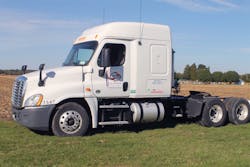Company: Schilli Transportation Services, Remington, IN
Operation: Dry van and flatbed truckload services as the trucking arm of a full-service logistics management company
Problem:
Running modified TMW TL2000 software on an IBM i-Series mainframe (originally the AS/400) has served Schilli Transportation well, says Lou Wilkinson. Until recently the fleet’s vice president of IT solutions and now semi-retired to run its IT development projects, Wilkinson says the big iron “is a great value proposition,” and he especially appreciates its reliability as a backend database. “I don’t think there’s been a bit of information lost since the mid 1990s,” he says. “Every three years or so we look at all the new systems out there, but so far the verdict has been to stay the course.”
Over the years, of course, his group has worked to upgrade the system to meet users’ changing expectations for software usability. “We added more functionality on the customer side of it,” he says, making it easier for them to do business with Schilli. “But we hadn’t done much on the operations side for our driver managers.”
A few years ago, Wilkinson’s department added a simplified screen to help each manager work with their assigned drivers. “Everything they need to know about their drivers—inspections, paperwork, ETA deviations and so on—is on that screen or just one keystroke away,” he says.
Solution:
While the Driver Daily Events (DDE) tool was a major advance for those frontline managers, it lacked one important feature—an integrated mapping solution. Instead, driver managers were using a free online mapping program that didn’t even provide truck-specific routes to manually create route maps for their drivers.
Working when time allowed over a six-week period, Wilkinson and his team were able to integrate truck-specific maps into the DDE. Provided by ALK Technologies, which like TMW is part of the Trimble family of transportation software companies, the new mapping capabilities not only added visual location cues for the managers, but also brought other related features that are proving both popular with the driver managers and the fleet’s management, not to mention its drivers.
Moving from the manual process to integrated mapping saves about 15 minutes for each load assigned, or an average of two hours a day for each manager. “That’s two hours every single day they get to work on hours of service, driver retention issues, and other more important things,” says Wilkinson. “And that’s not management BS; that’s what the end users are telling us.”
Using a truck’s current location and entering an endpoint, the mapping system only needs a single keystroke to present route options that include company fuel stops and approved hotels, future loads, and even turn-by-turn directions that can be relayed to the driver over Schilli’s OmniTracs system. Once a truck is assigned, the manager only has to hover over the truck icon on the map to get current information on location, available driving hours, speed and ETA. And managers can do quick visual checks of all their drivers and trucks just by looking at the map, which uses red, yellow and green alerts to indicate on-time delivery status for each.
The next step for Wilkinson’s team is extending the mapping system to Schilli’s load planners. “They sit between the EDI orders [from customers] and the driver managers,” he says. “We’re building something that puts uncovered routes and unassigned drivers on the maps so they can actually see where the loads and drivers are at any time.
“This is one [IT] project that every single person in the company loves,” says Wilkinson, “and that doesn’t happen very often for IT managers.”
About the Author
Jim Mele
Jim Mele is a former longtime editor-in-chief of FleetOwner. He joined the magazine in 1986 and served as chief editor from 1999 to 2017.
